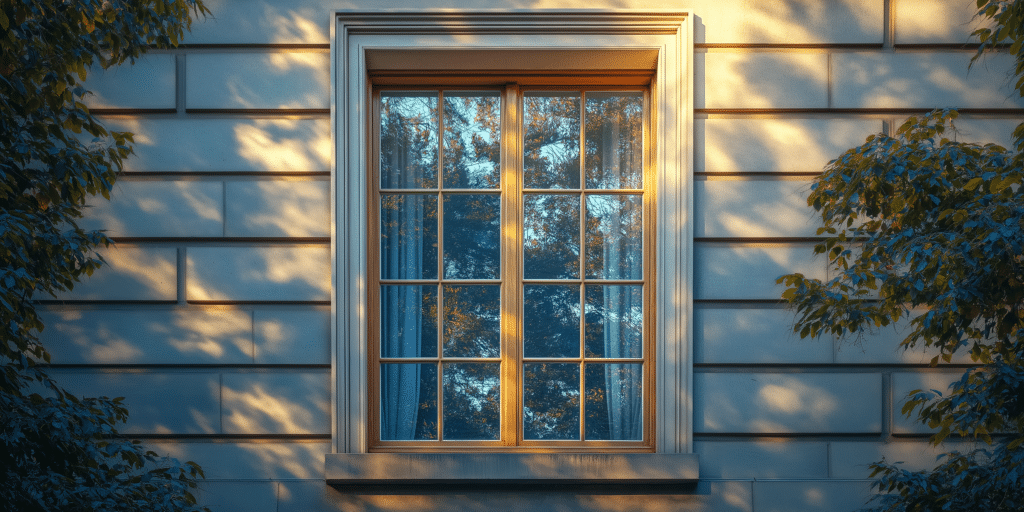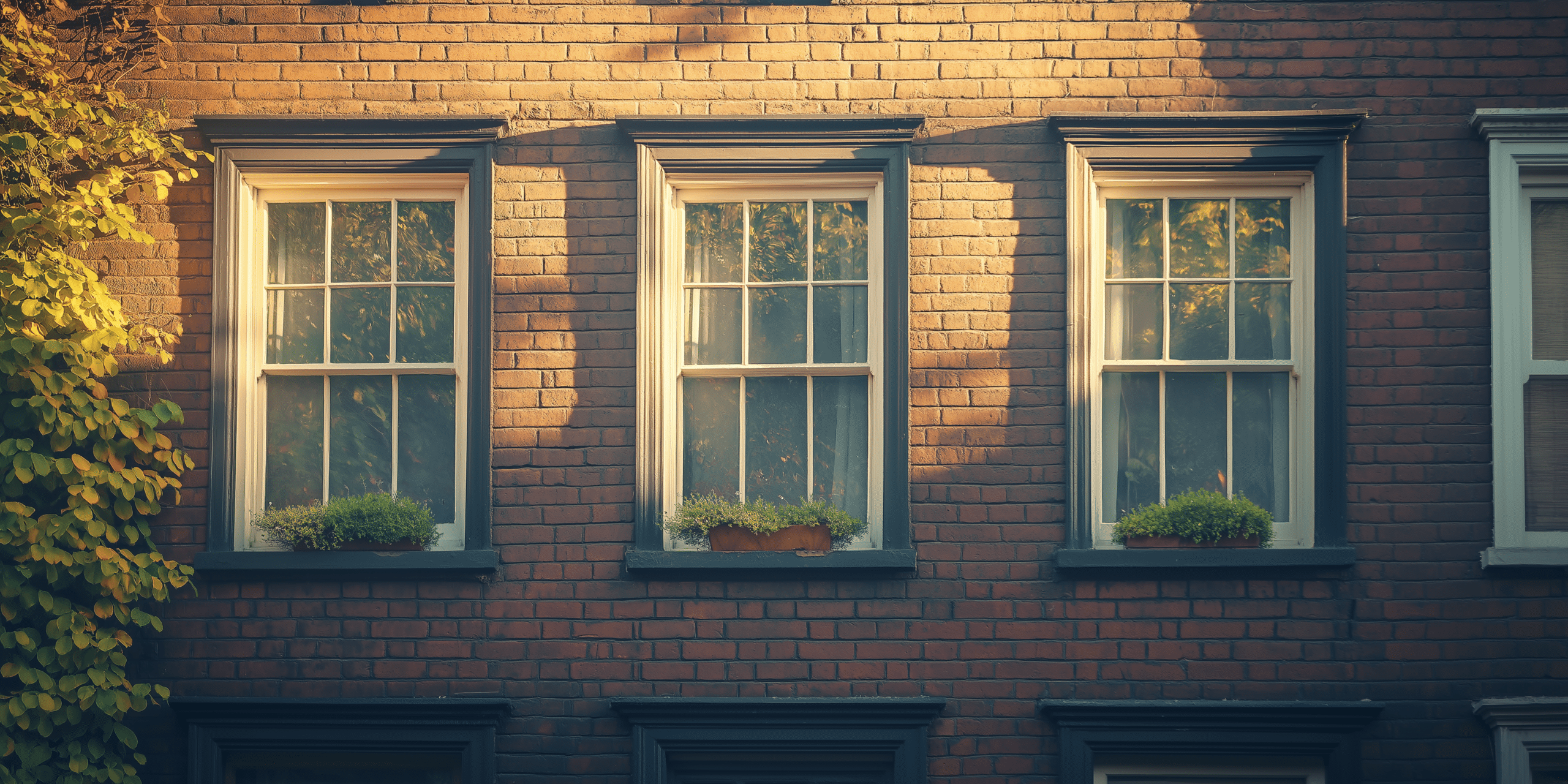What is U-Value and Why Does It Matter?

The U-Value is a measure of how well a window insulates against heat transfer. It’s expressed in watts per square metre per degree Kelvin (W/m²K). A lower U-Value indicates better insulation and reduced heat loss.
In period properties, maintaining a low U-Value is crucial for reducing energy costs and improving comfort. Poorly insulated sash windows can lead to significant heat loss, especially in colder climates. The U-Value directly impacts heating costs. Higher U-Values mean more heat escapes, leading to increased energy consumption to maintain comfortable indoor temperatures.
For listed buildings, optimising U-Values must be balanced with conservation regulations. Complying with standards like BS EN 673 (Glass in Building – Determination of Thermal Transmittance) is essential.
Factors Affecting U-Value in Sash Windows
- Glazing Type: The type of glazing used significantly affects the U-Value. Single glazing has a higher U-Value compared to double or triple glazing, which includes a gas-filled cavity and low-emissivity (Low-E) coatings. For example, double-glazed windows filled with argon gas typically achieve a U-Value of 1.4 W/m²K, while triple-glazed windows can go as low as 0.7 W/m²K.
- Frame Material: The material of the window frame, whether timber, aluminium, or uPVC, also influences the U-Value. Timber frames, while traditional, may require additional insulation to achieve a lower U-Value. Notably, some timber sash windows have achieved U-Values as low as 1.1 W/m²K.
- Thermal Bridging: This occurs when heat bypasses the insulation through conductive materials like metal sash weights or poorly insulated frames. Minimising thermal bridging is key to lowering U-Values.
- Weatherproofing and Draught Exclusion: Effective draught-proofing and weatherproofing can significantly reduce air infiltration, which improves the overall U-Value of sash windows. High-quality draught-proofing can reduce heat loss by up to 86%, contributing to better U-Values.
How to Measure and Calculate U-Value for Sash Windows
- Measuring U-Value: U-Value can be measured using specialised tools that assess the rate of heat transfer through the window. This involves calculating the thermal transmittance of both the glazing and the frame.
- U-Value Calculation Standards: Adhering to standards like BS EN 10077-1 (Thermal Performance of Windows, Doors, and Shutters) ensures accurate and reliable U-Value calculations.
- Factors in U-Value Calculation: The calculation takes into account the thermal conductivity of the glass, the frame, and any spacer bars, as well as the overall window assembly. Key factors include the Ug value (thermal performance of the glass), Uf value (thermal performance of the frame), and PSIG (thermal performance of the frame spacers).
- Understanding Thermal Transmittance: Thermal transmittance, a key factor in U-Value calculations, measures how much heat passes through a window. Lowering this figure is crucial for improving energy efficiency.
Improving U-Value Through Glazing Solutions

- Double Glazing Options: Replacing single glazing with double glazing can halve the U-Value, typically reducing it from around 5.0 W/m²K to 2.8 W/m²K. Advanced options include Low-E glass and argon gas fills, which can further lower U-Values.
- Triple Glazing for Enhanced Insulation: Triple glazing takes insulation a step further, potentially reducing U-Values to as low as 1.1 W/m²K. This is particularly effective in cold climates or for properties aiming for high energy efficiency. For example, triple-glazed sash windows from certain manufacturers can achieve U-Values as low as 1.1 W/m²K, significantly improving thermal performance.
- Low-E Coatings: Low-E coatings on glass reflect heat back into the room, further reducing U-Values. These coatings are crucial in preventing heat loss through the glass.
- Gas-Filled Units: Inserting inert gases like argon or krypton between glazing panes reduces thermal conductivity, lowering U-Values and improving energy performance. Argon-filled double glazing typically achieves a U-Value of around 1.4 W/m²K, which is almost twice as efficient as standard air-filled glazing.
The Role of Frame Materials in U-Value Optimisation
- Timber Frames: While traditional timber frames are aesthetically pleasing, they often require additional measures like insulation inserts or draught-proofing to achieve lower U-Values. Some advanced timber sash windows now achieve U-Values as low as 1.1 W/m²K, making them comparable to modern uPVC options.
- uPVC and Aluminium Frames: These materials offer better thermal performance with less maintenance. Modern uPVC frames can achieve U-Values as low as 1.3 W/m²K, thanks to multi-chamber designs that enhance insulation.
- Composite Frames: Combining materials like timber and aluminium can optimise both thermal performance and durability. Composite frames often have built-in thermal breaks that reduce U-Values and prevent thermal bridging.
- Heritage and Conservation Considerations: For listed buildings, selecting materials that comply with conservation guidelines while improving U-Values is essential. Bespoke timber frames combined with modern glazing technologies often provide the best solution.
Addressing Thermal Bridging and Sash Window Insulation
- Identifying Thermal Bridges: Thermal bridges occur where there is a gap or weakness in the insulation, such as around sash weights or at the junction between the frame and glazing.
- Insulating Around Sash Weights: Using modern sash weight systems, such as those with concealed counterbalances, can reduce thermal bridging and improve U-Values.
- Frame and Glazing Insulation: Applying insulation to the frame and using spacer bars with low thermal conductivity in glazing units can further reduce thermal bridging.
Advanced Draught-Proofing Techniques for Lower U-Value

- Draught-Proofing Methods: Installing draught seals around the perimeter of the sash and where the sashes meet can drastically reduce air infiltration, improving U-Values.
- Weatherstripping: High-quality weatherstripping materials, such as EPDM rubber or silicone, provide a durable seal against draughts while maintaining the traditional appearance of sash windows.
- Sash Cord and Pulley Insulation: Insulating around sash cords and pulleys can prevent cold air ingress, further improving the U-Value.
- Impact of Draught-Proofing on Energy Efficiency: Effective draught-proofing can reduce heat loss by up to 86%, contributing to a lower overall U-Value and increased comfort in period properties.
Compliance with Building Regulations and Conservation Guidelines
- Understanding Building Regulations: Regulations such as Part L of the Building Regulations in England require specific U-Values for new and replacement windows, even in conservation areas. Most new sash windows now need to achieve a U-Value below 1.4 W/m²K to comply with these standards.
- Conservation Area Compliance: In listed buildings, any modifications to sash windows must meet conservation guidelines. This often requires bespoke solutions that balance energy efficiency with historical accuracy.
- Achieving Compliance with Low U-Values: Achieving compliance while improving U-Values may involve using slimline double glazing, which fits within existing sash frames without altering their appearance. Some retrofit projects have achieved U-Values of 1.6 W/m²K, even within the constraints of listed buildings.
The Benefits of Retrofitting Sash Windows for Better U-Value
- Energy Savings: Retrofitting sash windows with better glazing and insulation can reduce heating costs significantly. Homeowners can expect to save up to 30% on energy bills, thanks to improved U-Values. For example, retrofitting with vacuum double glazing has been shown to achieve U-Values as low as 0.7 W/m²K.
- Enhanced Comfort: Lower U-Values lead to improved thermal comfort, reducing cold spots and draughts within the home. This not only enhances living conditions but also aligns with broader sustainability goals.
- Increased Property Value: Energy-efficient windows are a key selling point in the property market, especially in period homes where modern upgrades are tastefully integrated. Homes with optimised U-Values are often more attractive to buyers, who are increasingly prioritising energy efficiency.
- Environmental Impact: Reducing the U-Value of sash windows contributes to a lower carbon footprint, aligning with broader sustainability goals and reducing overall energy consumption. This is particularly important as homeowners seek to meet stricter environmental standards.
Selecting the Right Glazing and Frame Materials for Optimal U-Value

- Glazing Options: Choosing the right glazing, such as double or triple glazing with Low-E coatings and gas fills, is critical for achieving low U-Values. For example, using argon gas in double glazing typically results in a U-Value of 1.4 W/m²K, which is a significant improvement over air-filled units.
- Frame Material Selection: Selecting the appropriate frame material—whether timber, uPVC, or composite—can optimise thermal performance and durability. For instance, modern uPVC frames can achieve U-Values as low as 1.3 W/m²K due to their multi-chamber design.
- Bespoke Solutions for Heritage Properties: For listed buildings, bespoke timber frames with integrated insulation and modern glazing units provide a balance of tradition and efficiency. These solutions often achieve U-Values well below the regulatory thresholds, ensuring compliance and energy efficiency.
- Long-Term Considerations: When selecting materials, consider the long-term impact on U-Value, maintenance needs, and compatibility with conservation requirements. Future-proofing your windows with high-quality materials ensures sustained energy efficiency.
The Future of Sash Window Technology and U-Value Improvement
- Emerging Technologies: Innovations like vacuum glazing and smart windows with electrochromic glass are set to revolutionise U-Value optimisation in period properties. Vacuum glazing, for example, offers U-Values as low as 0.5 W/m²K, making it one of the most efficient options available.
- Automation and Smart Controls: Automated sash windows with integrated sensors and smart controls can dynamically adjust for optimal insulation and ventilation, improving both U-Value and comfort. This technology not only enhances energy efficiency but also offers convenience and flexibility.
- Sustainability in Window Design: Future developments focus on sustainable materials and manufacturing processes that further reduce U-Values while being environmentally friendly. Recycled materials and low-carbon manufacturing processes are expected to play a significant role in the future of sash window design.
- Predictions for U-Value Standards: As building regulations evolve, the demand for even lower U-Values will drive innovation in both glazing and frame materials, pushing the boundaries of what’s possible in window insulation. It is anticipated that future regulations will require U-Values of 1.0 W/m²K or lower for new installations.
Final Thoughts: Balancing Tradition and Efficiency in Sash Windows
While improving U-Values, it’s important to preserve the historical and aesthetic integrity of sash windows, especially in listed buildings. Achieving this balance requires careful planning and the use of sympathetic materials and technologies.
By carefully selecting materials and technologies, homeowners can achieve excellent thermal performance without compromising on the period charm of their property. This approach not only enhances energy efficiency but also respects the architectural heritage of the building. Investing in U-Value improvements pays off in long-term energy savings, increased property value, and enhanced comfort. These benefits are especially pronounced in period properties where energy efficiency can be more challenging to achieve.
For those considering sash window upgrades, the benefits of optimising U-Values are clear—start your journey towards energy efficiency and comfort today. With the right approach, it’s possible to enjoy modern comfort while preserving the character and charm of traditional sash windows.




